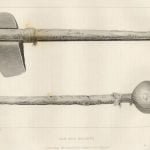
Various stone implements of the antique period of the hunter occupancy of America, have received the name of “Indian Axe.” With what justice this term was applied, in relation to the use made of the European axe of iron, it is proposed to inquire. The ancient Indians, prior to the era of the discovery of America, had indeed no use for an axe, in the sense in which we apply the term now a days. Fire was the great agent they employed in felling trees and reducing their trunks to proper lengths. There was no cutting of trees. No stone axe, which we have ever examined, possesses the hardness or sharpness essential to cut the solid fibers of an oak, a pine, an elm, or any species of American tree whatever.
When the wants of an Indian hunter had determined him to fell a tree, in order to make a log canoe, or construct pickets for a palisade, he erected a fire around it, close upon the ground. When the fire had burned in so as to produce a coal that might impede its further progress, a stone instrument of a peculiar construction, with a handle to keep the person from the heat, was employed to pick away the coal, and keep the surface fresh. This is the instrument called by them Agakwut, and to which popular opinion has usually applied the name of axe. The annexed, (Plate 14, Fig. 1,) is an exact representation of one of these antique axes, from the region of the upper lakes. De Bry pictures this process in making canoes.

The mode of using this ancient axe, which would be more appropriately classed as a pick, was by twisting around it, of a size corresponding to the ring, a supple withe, forming the handle, which could be firmly tied together, and which would enable the user to strike a firm inward blow. (See Plate 15, Fig. 1.) This handle was not at right angles with the axe. It was so placed, as the ring shows, so that at about the length of three feet, it would intersect a line drawn at right angles from the foot of the blade, or edge of greatest sharpness. This incidence of handle to the blade would enable an indrawing blow to be struck, which there were practical reasons for.
The length of the instrument figured is seven inches, wanting a fraction; its breadth below the ring three and a quarter at the ring, two and three quarter inches, at the point of the blade two inches nearly. The whole weight is three pounds. The ring is not continued around the inner, or handle side, for the plain reason that no ring at that part is necessary. If made, it would weaken the instrument and give no additional support to the handle. The material of this specimen is a compact grauwacke; a material of little hardness, and which could be readily rubbed and shaped.
To this account of the earliest stone axe, it may be objected that there are smaller specimens, so small indeed that they could not have been required for an adult. We possess a specimen three and two-third inches in length, and another only two and a quarter inches in length. It is replied that these small axes were adapted to the strength of boys and children, whose labors in the process of fire fretting were always welcome and important, and their aid was probably given, particularly when we reflect that this labor was generally done by the females.

Canoes of wood are known to have been excavated and shaped by the same process of fire, even after the discovery and settlement of the country. De Bry gives the process as practiced by the Indians of Virginia in 1688.
The small species of the coal axe, employed by youths and boys, are numerous. Figures 1, 2, 3, and 4, Plate 16, are from specimens preserved in the National Institute, Washington. Figure 5, same Plate, same locality, is believed to be a hand specimen of the same kind of implement. Figures 1 and 4, Plate 14, are from the West. Figure 2, of the same Plate, is believed to be a hand specimen, formed chisel-shaped. Figure 3 is a drawing reversed, from an antique in the National Institute which appears to have had an eye for a helve, and presented a blade well formed for striking an indrawing stroke.
